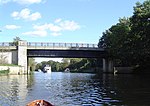North West Surrey Synagogue
1956 establishments in EnglandEuropean synagogue stubsReform synagogues in the United KingdomReligion in SurreyUnited Kingdom religious building and structure stubs ... and 2 more
Use British English from August 2015Weybridge, Surrey

North West Surrey Synagogue is a Reform Jewish community whose synagogue is on Oatlands Drive in Weybridge, Surrey, England. The community, which now consists of 300 families, was founded in 1956 and is affiliated to the Movement for Reform Judaism.The synagogue's current rabbi (since 2017) is Kath Vardi. Its previous rabbis have included Tony Bayfield (1969–1982), Frederick Morgan (1984–1997), Jackie Tabick (1999–2013) and Dr David Zucker (2013–2017).
Excerpt from the Wikipedia article North West Surrey Synagogue (License: CC BY-SA 3.0, Authors, Images).North West Surrey Synagogue
Horvath Close,
Geographical coordinates (GPS) Address Nearby Places Show on map
Geographical coordinates (GPS)
| Latitude | Longitude |
|---|---|
| N 51.3725 ° | E -0.4382 ° |
Address
Horvath Close
Horvath Close
KT13 9NG
England, United Kingdom
Open on Google Maps









